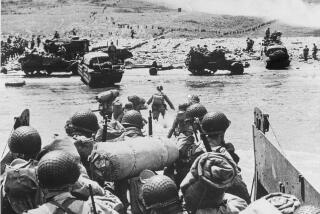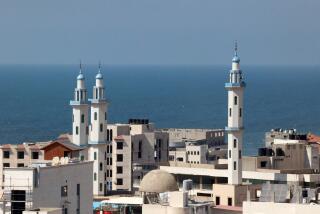Where the beginning of World War II came to an end
- Share via
The military turning point of World War II came in November 1942, 60 years ago, at three different places on the globe. At El Alamein in Egypt, the British 8th Army won a battle against the German-Italian African army and began its march westward. A week later, American and British forces landed in Morocco and Algeria, establishing a second front, eventually clearing all of Africa of German and Italian troops. Twelve days later, Russian armies, west of Stalingrad, encircled the German 6th Army, turning hopeful attackers into hopeless defenders.
Something similar was developing in the vast reaches of the Pacific too: By the end of November, the Japanese at Guadalcanal were no longer advancing but retreating (for the first time in the Pacific war), though this was not as sudden or dramatic. On Nov. 15, for the first time since 1940, church bells rang all over Britain. They had been silent for two years, ordered previously to be rung only in the event of a German landing in England.
But Churchill warned his people: “Now this is not the end, it is not even the beginning of the end. But it is perhaps the end of the beginning.” Yes, November 1942 was only the end of the beginning. The Germans fought on for 2 1/2 years, until the bitter end. Their fighting ability inspires the interest of people in World War II -- ask publishers, booksellers, filmmakers: That interest goes on and on. Nothing like this happened in World War I. The reputation of no German general in World War I comes even close to Erwin Rommel’s in the second.
The battle of El Alamein is the subject of three books, published, whether by coincidence or not, around this 60th anniversary. They are different books, but very good ones. Jon Latimer’s “Alamein” is the work of a former British Army officer, a meticulous military history inclusive of accurate and often hitherto unknown details. It is a classic, near-encyclopedic reconstruction.
So is “The Battle of Alamein” by John Bierman and Colin Smith, both journalists, whose research too is faultless. It is slightly longer than Latimer’s “Alamein” and includes interesting marginal matters (for example, the reconstruction of the doings of Laszlo Almasy, the protagonist of Michael Ondaatje’s novel “The English Patient”). Stephen Bungay’s “Alamein” is the work of an amateur military historian, the shortest book of the three: terse and brilliantly written by a thorough master of his subject, with perhaps more emphasis on the political background than in the others.
I read the three books in succession, without a sense of weariness or repetition, even when turning the pages describing the same episodes, the same phases of the 10-day battle and the same personages. It occurred to me that few, if any, professional historians may be able to attain the quality of these books.
In addition, every historian of World War II may learn a few of these, chosen at random: The Italian soldiery fought better at El Alamein than has been customarily assumed. As late as seven days after Gen. Bernard Law Montgomery launched the battle, the outcome was still uncertain -- a draw was still possible. German armor was certainly better than Allied armor, even including the newly arrived American Sherman tanks. Air superiority was less decisive at El Alamein than over the Mediterranean, where British air (often assisted by precious information from “Ultra”) was able to destroy most of the vessels that were shipping precious fuel to Rommel’s overextended supply lines. Desertions were few. Contrary to many of his critics, Montgomery deserves full credit for El Alamein, where British superiority in manpower and armor was 2 to 1, not the threefold or even greater advantage often attributed to Montgomery. (Hemingway called -- loudly -- his 15-to-1 gin-laden martini a “Montgomery.”)
Five days after Montgomery’s 8th Army finally broke through at El Alamein, American (and smaller British) forces landed in French North Africa, in Morocco and Algeria. “An Army at Dawn: The War in North Africa, 1942-1943,” the first volume of a planned trilogy by journalist Rick Atkinson, is precise, on occasion sparkling; Atkinson’s research is extensive; his conclusions are unexceptionable.
“An Army at Dawn” also includes new and fascinating material. The French did more damage to the American landings between Nov. 7 and 11 than has been generally accepted. American generals, including Eisenhower, were almost without exception wanting in dispatch and energy. Rommel’s counterattacks and his defense against overwhelming American and British power may have been even more stunning than his last-ditch holding efforts during Alamein. Yet this is not the work of a debunker but of a thoughtful and deeply interested historian, with a theme that rises and then resounds at the end: The North African campaign in the winter and spring of 1942-43 was necessary, for it was then and there that an insufficiently trained and inexperienced American soldiery learned the grim experiences of battle and turned out to be a good and reliable fighting force.
There is a moral in these books, to be considered by all historians of World War II: The North African campaigns, debouching into Sicily and Italy -- Churchill’s favorite Mediterranean strategy -- were not mistaken. For many years, military, political, academic and amateur historians (beginning with J.F.C. Fuller -- a bitter opponent of Churchill -- and recently by Corelli Barnett) have argued, at times convincingly, that instead of landing in French North Africa, the Allies should have invaded France in 1943 and made straight for Berlin. That was the original American plan, but almost everything we know now about the Germans’ strength and disposition suggests that this could have been a disaster. The military and material strength of the Third Reich in 1943 was still sufficient to defeat an Anglo-American invasion -- or, more likely, to force the Western Allied armies to halt and dig in somewhere in western France, which is what Churchill had feared.
As it happened, the Germans lost almost 200,000 men in North Africa, Sicily and southern Italy, much armor and a portion of their air forces, and at least a large part of Italy was knocked out of the war. The dispersion of German power to the Mediterranean cost them as much as the dispersion of the Anglo-American effort in the Mediterranean cost the overall Anglo-American thrust toward Germany. There is more to this than “counterfactual” history of mere speculation. It is something that we may recognize only after a long and weary retrospect. It is that in human affairs things turn out in the way they had to turn out, ever so often. Perhaps even always.
More to Read
Sign up for our Book Club newsletter
Get the latest news, events and more from the Los Angeles Times Book Club, and help us get L.A. reading and talking.
You may occasionally receive promotional content from the Los Angeles Times.










